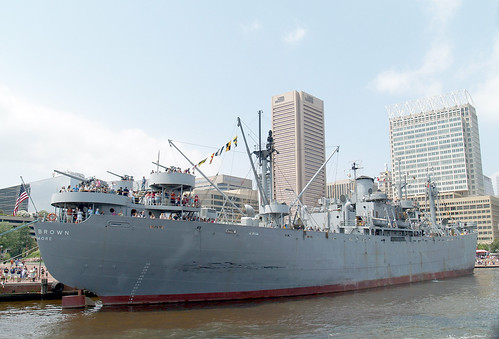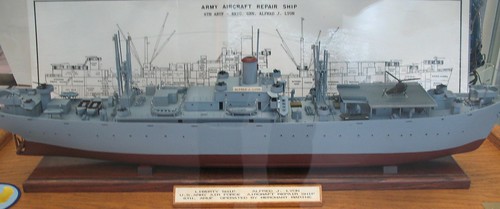

Liberty ship layout
The SS John W. Brown is a World War II cargo ship built by the U.S. Maritime Commission. In 1942, she was built in 41 days at the Bethlehem-Fairfield Shipyard in Baltimore, Maryland. She was launched on Labor Day, September 7, 1942. The ship was named after an American labor leader who organized workers in shipyards.After being launched, the ship sailed to New York and departed on its maiden voyage on September 29, 1942 carrying supplies to the Middle East. In 1943, the ship was converted to carry troops as well as cargo. Later, the John W. Brown supported combat operations in the Mediterranean Sea. The ship was involved in the Allied landings at Sicily and Anzio in Italy, and southern France. After the war ended in Europe, the John W. Brown carried U.S. military personnel home.About 2,700 Liberty ships were made during the war, and about 200 were sunk. Where possible, bulky war machines, (like cargo ships that required much raw material)--were made in the U.S.; allowing England’s labor force to concentrate more on labor intensive, smaller, technical machines (like their fine Spitfire fighter planes, and mine detecting and destruction equipment, and so on).
Liberty ship model
LIBERTY SHIP: It became obvious, after WW2 began, that the Allies’ mounting loss of ships, to enemy subs (U-boats) was a major obstacle to the Allied effort; and, in fact, England might starve. And Soviet Russia’s manufacturing capacity and resources were also soon greatly reduced by initial German territorial gains. And the Soviets lost their labor force in areas occupied by Germany. So an astute U.S. Administration, with good advisors and technical experts, drafted plans to manufacture great numbers of Merchant ships, using cheap, non-scarce materials, and high-efficiency technology. And the ships were to have great cargo capacity. Welding would replace rivets; large prefab sectionswould be utilized where possible.
The value of the cargo carried by a Liberty ship often far exceeded the value of the Liberty ship, itself. If such ship could just make only one successful delivery to the Allies, it thus “paid for itself”. Suppose, a Liberty ship carried 440 tanks weighing 8000 tons total and worth $18,000,000. That value would obviously dwarf the $1,600,000 cost of the ship, itself. In fact, that is a strong argument for dispersing especially valuable cargo among various Liberty ships, so that an Ally receiving it does not find itself totally lacking in any one class of equipment, indispensable for carrying on the war. (Occasionally there were “too many of a particular type of ‘eggs put in one basket’, i.e., loaded on one Liberty ship”.) Incidentally, a ship’s steam engine is designed to re-condense, recover, and recycle its de-energized warm steam, after each cycling sequence. And therefore, it need not make water stops or scoop up cool water for its engines; which railroad steam locomotives, unfortunately, have to do. (Large WW2 Warships, propelled by steam turbines, produced and utilized high steam pressures of 575 psi., which seems much higher than steamlocomotives of the period, i.e., 250 psi.)
The ships’ shape, propulsion, and general design were based on a cheap, old “tramp” ship that had been commercially successful.I think it was fortunate, at least, that fuel oil was chosen, instead of coal to power Liberty ships, because that required much less crew, who might be killed or injured if the ship was torpedoed. And the U.S. Merchant Marine Service suffered a higher percent killed than any the large ‘military’ Branch of the Services; and did not need matters made still worse. (Of course, certain specialty services within each major Service, such as the U.S. Submariners, suffered even higher percentage killed.) Oil fuel also increased the Liberty Ship’s efficiency. In 1940, about 40% of the world’s ships still used coal. Coal was much more commonly used in merchant ships, then; and was generally avoided for military ship propulsion. It was decided that Liberty ships would used cheap and relatively available engines, ((i.e., the triple expansion, reciprocating steam engines--even though their relatively low power output (totaling 2,500 HP) propelled the large ships slowly enough to be followed for a while, even by submerged U-boats.)
Liberty Ship Technical Specifications
Speed: 10.5 knots (12 mph), presumably even when fully loaded.
Gross weight (i.e., weight of empty ship): 7000 tons
Cargo weight (applicable to ship’s “full load displacement” rating):7000 tons
Full load” Displacement (Gross weight + full-load cargo weight):14,000 tons
The so-called “Deadweight” (i.e., amount of Cargo, and the ship’s own Fuel, etc., which the ship could carry on emergency missions if seas didn’t become too rough, or in calm lakes, etc.): …… 10,500 tons
Size:430 feet long; 57 feet beam (max width); 27 feet draft (depth into the water).
Power: total 2,500HP, from reciprocating steam engines.
Fuel: Oil
Crew: about 56 to 80; ((about 12 to 25 of those would likely be Navy personnel (guards) to man the ship’s several defensive guns. The number of these guns per ship increased during the war))
Friday, August 14, 2009
ww2 Liberty ship Specifications
Subscribe to:
Post Comments (Atom)



0 comments:
Post a Comment